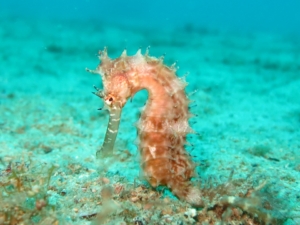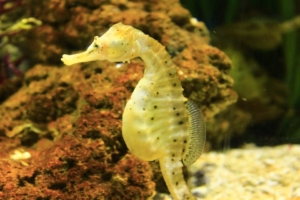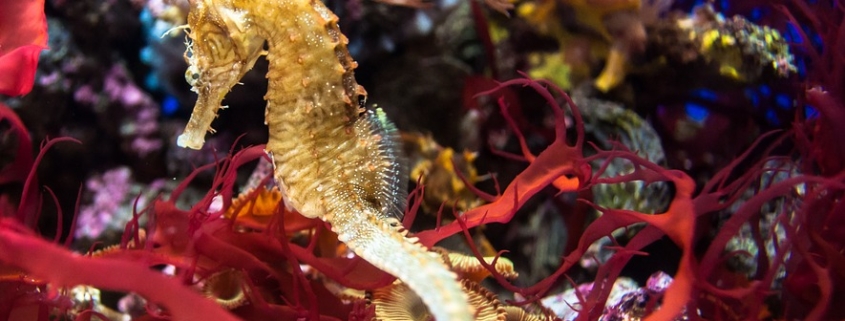Seahorses are among the most docile animals in the oceans. Characterized by their horse-like body — particularly their head, neck and tail — they live primarily in shallow, medium-temperature saltwater. As a diver, you’ve probably encountered seahorses while exploring underwater environments. Even if you’re familiar with their distinguishable horse-like appearance, though, there are probably some things you don’t about seahorses. Below are eight fun facts about seahorses that will help you appreciate these docile marine animals a little more.
#1) Seahorses Can Move Their Eyes Independently
As explained by the Professional Association of Diving Instructors (PADI), seahorses can move their eyes independently of each other. In other words, their eyes can look in different directions. A seahorse’s left eye may look backwards, whereas its right eye may look forwards. Marine biologists believe that seahorses developed this evolutionary trait for hunting purposes. Because seahorses hunt by sight, the ability to move their eyes independently allows them to find prey more easily. If seahorses had fixed eyes, like most humans, they would struggle to find prey while scouring the ocean floor.
#2) There Are 47 Known Species of Seahorses
 Marine biologists have identified 47 species of seahorses, according to Smithsonian Ocean. Of those 47 species, 14 were identified within the last decade. All species of seahorses are classified as fish in the genus Hippocampus. And they all share the same horse-like appearance. Of course, no two species are exactly the same. Each species has its own unique characteristics and traits that distinguish it from the rest.
Marine biologists have identified 47 species of seahorses, according to Smithsonian Ocean. Of those 47 species, 14 were identified within the last decade. All species of seahorses are classified as fish in the genus Hippocampus. And they all share the same horse-like appearance. Of course, no two species are exactly the same. Each species has its own unique characteristics and traits that distinguish it from the rest.
Some of the most common species of seahorses include the following:
- Dwarf seahorse
- Northern seahorse
- Long-snout seahorse
- Short-snout seahorse
- Japanese seahorse
- Flat-faced seahorse
- Tiger tail seahorse
- West African seahorse
- Hedgehog seahorse
- Spiny seahorse
- Zebra seahorse
- Crowned seahorse
- Zebra seahorse
- Pacific seahorse
- Pygmy seahorse
#3) Many People Seahorses as Pets
While not as popular as dogs and cats, seahorses are often kept as pets. They are attractive, fun-loving marine animals that are guaranteed to liven up an otherwise dull saltwater aquarium. With that said, raising a seahorse as a pet requires extra care. Seahorses don’t fare well in saltwater aquariums with other, faster and more aggressive fish. Attempting to raise a seahorse alongside a predatory fish, for example, may result in malnutrition. The predatory fish will consume the food, whereas the seahorse is left fighting for any scraps.
Seahorses can still coexist in the same saltwater aquarium as other fish — you just need to choose the right type of fish. Bottom-feeding “suckers” are perfectly fine because they don’t eat the same food as seahorses. On the other hand, you should avoid adding eels, squid or triggerfish to your saltwater aquarium if you’re planning to raise a seahorse.
Seahorses require specific environmental conditions to thrive and stay healthy when kept as pets. This includes a water temperature of 73 to 82 degrees Fahrenheit as well as a pH level of 8.1 to 8.4. If you’re not willing to constantly monitor the temperature and pH level of your saltwater aquarium, you may want to choose a different fish to raise. Nonetheless, seahorses can make an excellent addition to your saltwater aquarium, assuming you offer them an appropriate environment.
#4) Seahorses Are Slow Swimmers
Although they are majestic, seahorses are slow swimmers compared to most other fish. In fact, the dwarf seahorse is currently listed in the Guinness Book of World Records as being the slowest-swimming fish in the oceans. Found primarily in U.S. coastal waters, as well as the Bahamas, it has a top speed of just 5 feet per hour. To put that number into perspective, feet per hour translates into 0.01 mph. That’s slower than all other fish in the oceans.
One of the reasons seahorses are such slow swimmers is because they are small. Generally speaking, smaller fish swim slower and more poorly than larger fish. With their smaller size, they can’t fish underwater currents as easily as larger fish. This rings true for all small fish, and seahorses are no exception.
Due to their poor swimming abilities, seahorses struggle to sneak up behind prey undetected. As a result, they typically jerk their long nose forward to attack prey. It’s a swift and sudden attack that prevents the prey from escaping.
#5) Some Seahorses Less Than an Inch When Fully Grown
Did you know that some seahorses are less than an inch tall when fully grown? The dwarf seahorse is undoubtedly small, with most full-grown dwarf seahorses measuring just 2 inches tall. The world’s smallest seahorse, however, is less than half this size. Known as the pygmy seahorse, it has an average height of just 0.79 inches when fully grown.
Pygmy seahorses are found in the coastal waters of Southeast Asia, especially in and around the Coral Triangle. However, their highly camouflaged skin makes them difficult to spot. Pygmy seahorses often rest on the seabed where they blend into the surrounding seagrasses and corals. Combined with their small size, they are incredibly difficult to spot when diving. You typically won’t see a pygmy seahorse until it begins swimming around, and that’s only if you have keen eyesight.
#6) Seahorses Can Eat Up to 3,000 Brine Shrimp Per Day
 Don’t let their small size fool you into thinking seahorses are lightweight eaters. It’s not uncommon for seahorses to eat up to 3,000 brine shrimp each day. Furthermore, seahorses usually eat between 20 and 50 times per day, with each session consisting of hundreds of brine shrimp.
Don’t let their small size fool you into thinking seahorses are lightweight eaters. It’s not uncommon for seahorses to eat up to 3,000 brine shrimp each day. Furthermore, seahorses usually eat between 20 and 50 times per day, with each session consisting of hundreds of brine shrimp.
Unlike many other fish, seahorses don’t have teeth. As a result, they are unable to chew food. When hunting, seahorses simply swallow their prey whole. In addition to brine shrimp, seahorses also consume plankton, small fish and the occasional algae.
#7) Seahorses Mate for Life
Like penguins, seahorses are monogamous animals that mate for life. During the mating season, female seahorses will deposit over 1,000 eggs into a male seahorse’s pouch. For the next 10 to 45 days, the male seahorse will carry these eggs until they’ve hatched. The baby seahorses — known as fry — are then released from the male’s pouch, at which point they’ll go their own way. Unfortunately, research shows only about one in 200 fry survive to reach adulthood. Marine biologists believe seahorses’ low infant survival rate is the reason why they lay so many eggs.
What’s truly impressive about seahorses’ mating behaviors, however, is that they mate for life. Although there are exceptions, most species of seahorses continue to mate with the same partner of the opposite sex. Their faithful companionship is just one more trait that makes seahorses such a unique marine animal.
#8) Seahorses Use Their Tail as an Anchor
There’s a reason seahorses have a long horse-like tail: It’s used as an anchor. As previously mentioned, seahorses are slow and poor swimmers. If there’s a strong underwater current present, a seahorse may struggle to hold its position. To overcome this challenge, seahorses use their tail as an anchor.
After finding a nice place on the ocean floor, a seahorse will wrap its tail around nearby seagrass or coral. The tail essentially anchors the seahorse to the ocean floor, thereby securing it in place. Even when faced fast-moving underwater currents, a seahorse can stay in place by using its tail as an anchor. If a seahorse wants to move to a different area, it will release its tail from the seagrass or coral.
Want to create your own custom dive logs? Contact us today to learn more about our custom dive logs.



